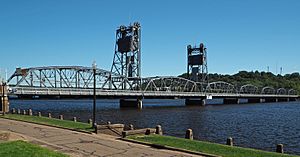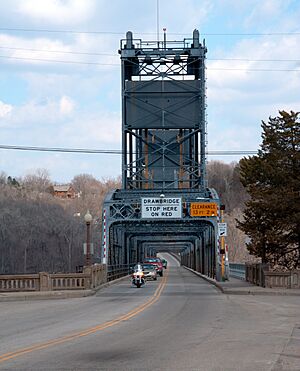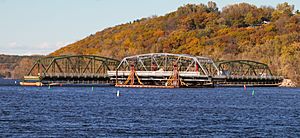Stillwater Bridge (St. Croix River) facts for kids
Quick facts for kids Stillwater Bridge |
|
|---|---|

The Stillwater Bridge from the southwest
|
|
| Carries | Bicycle and pedestrian traffic |
| Crosses | St. Croix River |
| Locale | Stillwater, Minnesota |
| Maintained by | Minnesota Department of Transportation |
| ID number | 4654 (Minnesota), M-61 (Wisconsin) |
| Characteristics | |
| Design | Vertical-lift bridge |
| Total length | 1,050 feet (320 m) |
| Width | 23 feet (7.0 m) |
| Longest span | 140 feet (43 m) |
| History | |
| Opened | 1931 |
| Closed | August 2, 2017 |
| Statistics | |
| Daily traffic | 18,000 |
|
Stillwater Bridge
|
|
| Area | Less than 1 acre (0.40 ha) |
| Built | 1931 |
| Built by | American Bridge Company, Peppard and Fulton |
| Architect | Ash, Howard, Needles, and Tammen; Minnesota Department of Highways |
| NRHP reference No. | 89000445 |
| Added to NRHP | May 25, 1989 |
The Stillwater Bridge is a special kind of bridge called a vertical-lift bridge. It crosses the St. Croix River. This bridge connects the city of Stillwater, Minnesota, with Houlton, Wisconsin.
For many years, the Stillwater Bridge carried cars and trucks. About 18,000 vehicles used it every day. In 2017, a new bridge called the St. Croix Crossing opened nearby. This new bridge took over the job of carrying highway traffic.
Now, the Stillwater Bridge is used only by people walking or riding bikes. It was saved because it is an important historical landmark. It was added to the National Register of Historic Places in 1989. This means it's a special example of engineering.
The bridge is made of seven fixed steel sections. It is about 1,050 feet (320 meters) long in total. The part that lifts up is 140 feet (43 meters) long. The bridge is 23 feet (7 meters) wide. It was built in 1931 and cost about $460,174.
Contents
Bridge History: How It Changed Over Time
The Stillwater Bridge has been repaired and updated many times. In 2005, the Minnesota Department of Transportation closed the bridge for major repairs. This project cost $5 million. Workers replaced the bridge deck, which is the road surface. They also fixed the small house where the bridge operator works. The bridge reopened in November 2005.
In July 2008, a truck that was too tall hit the bridge. This caused damage, and the bridge had to close for repairs. It reopened a few weeks later in August 2008. In 2012, the bridge closed again for more steel repairs.
Building a New Bridge Nearby
Plans were made to build a new, bigger bridge nearby. This new bridge would have four lanes for cars. The old Stillwater Bridge would then be used only for walking and biking. At first, the new bridge was planned for 2024. But laws changed, and the start date moved up to 2013. There were some legal challenges, but the new bridge, the St. Croix Crossing, finally opened in 2017.
A Special Model for Everyone
In 2009, a company made a detailed model of the Stillwater Lift Bridge. This model was special because it was designed for people with vision problems. It helped everyone understand the plans for the bridge.
The model used different textures and materials. For example, sandpaper showed bumpy warning areas. Raised lines showed crosswalks. Everything on the model had both large text and Braille labels. This made it easy for people with low vision to explore the bridge by touch.
Why the Bridge Needed a Replacement
The Stillwater Bridge had some challenges, especially with traffic. It led right into downtown Stillwater. This often caused traffic jams, especially on weekends. The problem got worse when the bridge had to lift up for boats.
The bridge's lifting parts were very old. They were almost the same as when it opened in 1931. Sometimes, the lifting parts would get stuck.
Also, inspectors said the bridge was "structurally deficient." This means it needed a lot of repairs to be safe for cars. It was also called "fracture critical." This means if one important part broke, the whole bridge could be at risk. There were no backup parts to keep it standing. The bridge also had limits on how tall or heavy vehicles could be. It could only hold vehicles up to 13 feet 2 inches (4 meters) tall and 40 tons (36 metric tons) in weight.




